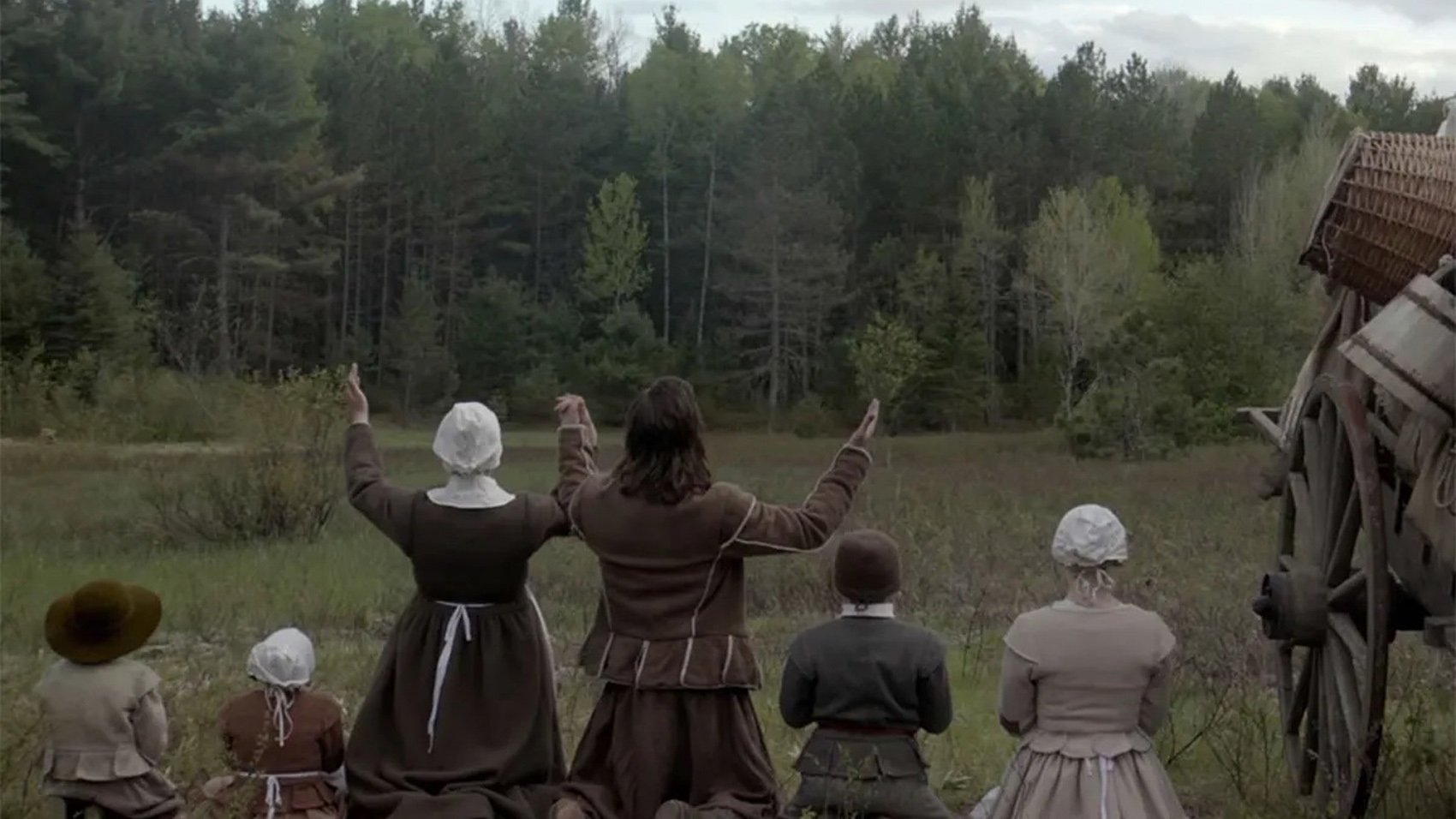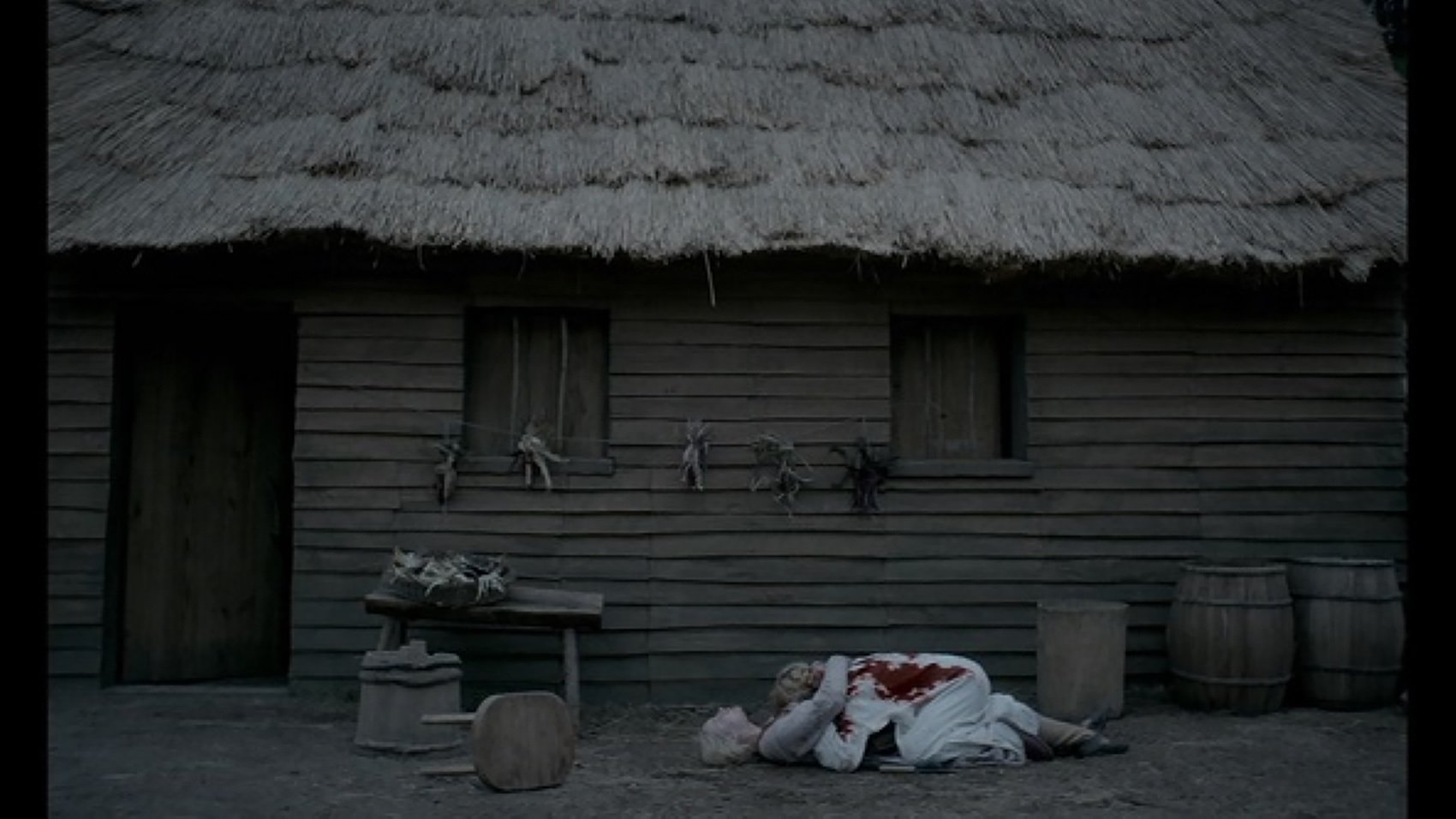[Editorial] Blood, Guts and Mommy Issues in The Witch (2015)

The Witch (2015), written and directed by Robert Eggers, is a horror movie about the most terrifying phenomenon to befall a young woman: mommy issues. While the movie is beloved for a variety of reasons, such as for its haunting visuals, eerie soundtrack, and feminist overtones, it is seldom recognized for its fascinating portrayal of mother-daughter conflict.
The film follows a Puritan family, cast out from the relative safety of their early American settlement, as they attempt to forge a new life in the uncharted forests of New England. They settle upon an open and isolated clearing, bordered on all sides by dark woods, and begin planting crops, raising livestock, and setting traps for rabbits and other small creatures. The land appears to be a godsend, a haven for the family to start anew after their ostracization due to patriarch William’s extreme religious beliefs. However, they quickly learn, as their crops begin to fail, their traps remain empty, and their children start to go missing, that the woods surrounding their small homestead are far from heavenly. Instead, lying in wait within the trees is a coven of witches who weaponize their magic in an attempt to catalyze the destruction of the entire family unit.
I rewatched the film earlier this year for an essay I was writing on witches and the aged female form in horror. The movie is one of my all-time favorites, and ever since I first saw it in theaters, I’ve been obsessed with it. With this in mind, I thought, mistakenly, that thanks to all I’ve read, written, and watched in relation to the film, I’d find nothing too revolutionary in this rewatch. However, as I attempted to take notes on the witches and their magic, I found that instead, all I could focus on was the intense relationship between the protagonist Thomasin and her mother Katherine. Their tension is palpable in many of their scenes together as they bicker over seemingly minute issues, such as a missing cup, and later erupts in violence over serious accusations of infanticide and incest. In fact, upon this rewatch I realized that most of the major conflicts in the film are either directly caused by or tangentially related to this tension.. As opposed to the overt supernatural attacks perpetrated by the witches in the woods, there is something insidiously routine and perhaps, for some audience members, familiar about Katherine’s resentful hatred towards Thomasin and her daughter’s desperate attempts to achieve her mother’s love. So familiar, in fact, that the phenomenon of mother-daughter conflict has spawned its own movie category on sites such as Letterboxd, where a cursory search of ‘mommy issues’ brings up over 200 curated lists. Mommy issues have found their own special niche specifically in the horror genre, with infamous horror films like Psycho, Black Swan, Carrie, and Hereditary focusing primarily on the horror derived from a strained relationship with one’s mother.
LISTEN TO OUR HORROR PODCAST!
![[Ghouls Podcast] Ghouls Watch: Bucket List of the Dead, Blood Drive, Candy Land & more](https://images.squarespace-cdn.com/content/v1/5fe76a518d20536a3fbd7246/1696261000263-58VQFOVWPE363OFGP7RF/GHOULS+WATCH.jpg)
The Witch joins this lineage of maternal horror in its taut depiction of the volatility and complexity of mother-daughter conflict. Throughout the film, Katherine repeatedly accuses Thomasin of trying to destroy the family unit, hurling increasingly horrific accusations at her. In response to her mother’s obvious bitterness, Thomasin self-flagellates with prayer and takes on a larger load of household tasks in a heart-breaking attempt to be loved. Regardless, nothing Thomasin does seems to dampen her mother’s hatred, and in fact, any action she does take exacerbates it. Babysitting her baby brother results in accusations of neglect, while helping her father wash and repair his clothes results in accusations of incest. While some of this tension can be ascribed to the witches’ occult influence, it is notable that Thomasin and Katherine are still able to maintain some semblance of a loving relationship with the other members of the family, just not with each other. This signals that their conflict has been brewing long before the witches entered the fold, thus mirroring the typical, simmering resentment that commonly undergirds mother-daughter relationships as the daughter comes of age and the mother ages. In familiar horror movie fashion, this resentment manifests viscerally in the film, as the maternal conflict spills over into rage, violence, blood, and gore. There are a number of scenes that utilize viscera and violence to express the complexity and intensity of mother-daughter conflict. While there are various trivial spats between the two, the two primary conflicts that undergird the tension between Thomasin and Katherine are 1. the loss of baby Samuel and 2. Thomasin’s burgeoning sexuality.

While the disappearance of Samuel is primarily one of the first signs of malevolence in the woods, it is also the audience’s first sign that all is not well between mother and daughter. Samuel vanishes suddenly from his bundle of blankets under Thomasin’s watch as she plays with him in front of the dark tree line. For Katherine, this loss triggers an emotional breakdown, and she quickly blames Thomasin for Samuel’s disappearance, even though her husband and younger children insist it was a wolf or another large animal who took Samuel. Katherine’s accusations, while coming from a place of understandable emotional instability, are ultimately irrational as they do not take into account the fact that the family is, for all intents and purposes, in the wilderness, surrounded by an unfamiliar landscape that houses wild animals perfectly capable of snatching an infant. Katherine’s immediate placement of this blame on Thomasin, despite the denials of other family members and the generally illogical nature of her claims, underscores the preexisting and currently mounting tension between mother and daughter. It is also undoubtedly a starkly familiar scene to those with strained relationships with their mothers. The scapegoating of daughters for the woes of the nuclear family unit is a common phenomenon, one that is often weaponized by the mother in order to justify her alienation of the daughter.

The audience eventually learns, in a haunting visual sequence, that Samuel has actually been kidnapped and brutally killed, his body pulverized by one of the grotesque and wrinkled witches living in the woods, who slathers the resulting mixture of blood, guts, and skin onto her body to perform a spell. In reading the film as an articulation of mommy issues, this bloody scene takes on a more symbolic hue. This destruction of the child symbolizes the destruction of Thomasin’s innocence, specifically in Katherine’s eyes. The baby, in this reading, represents Katherine’s understanding of Thomasin as her own blameless child. The murder of the baby is thus the murder of Thomasin’s child self and, by proxy, her connection to her mother. She is no longer allowed access to her mother’s maternal care or love and is instead forced to confront the harsh reality of becoming a woman and therefore a potential threat to her mother. In this vein, it is important to note that the blood, gore, and other viscera in this scene of infanticide can also be read as a representation of a menstrual cycle. This reading is strengthened by the image of the witch rubbing the newborn baby’s blood on her nude body, a combination of blood, the naked female form, and reproduction that immediately connotes menstruation, albeit a perverse representation of it. This reading, combined with the aforementioned analysis of the murder of the baby as the murder of Thomasin’s innocence, positions Thomasin’s maturation as dangerous to her mother, offering a potential explanation of her mother’s resentful hatred.
LISTEN TO OUR HORROR PODCAST!
The concept that Thomasin’s blossoming body poses a threat to her mother’s aging body is supported by the second accusation Katherine makes against Thomasin in the film, that she is engaging in incest with her father. This second aspect of the mother-daughter conflict in the film follows the same general format as the previous one in that the mother again makes an illogical accusation against the daughter that attempts to place the brunt of the blame for the family’s misfortune onto her. However, this accusation is key in that it reveals a deeply disturbing but unfortunately foundational facet of the tension that often underlies mother-daughter conflict. Instead of offering her maturing daughter the guidance and love she desperately needs, Katherine instead treats Thomasin as an adversary. In Katherine’s eyes, Thomasin’s natural development into a woman threatens her own hold over her husband and over the family unit as a whole. First Thomasin “loses” her baby, thus stripping Katherine of her maternal duties, and now Thomasin is trying to seduce her husband, stripping her of her wifely duties, thereby completely nullifying her capabilities as a sexually reproductive woman. As illogical and horrific as these accusations are, Katherine seems to truly believe them. The film represents the horrific nature of this belief via Katherine’s nightmarish hallucination.

Near the end of the film, following the death of Caleb, Katherine’s second eldest child, and the banishment of the family’s other children, including Thomasin, to the sheep shed, Katherine awakens in the night. Upon descending from her sleeping quarters, she finds a ghostly Caleb sitting in a chair holding baby Samuel. She weeps happily, taking Samuel into her own arms, insisting he is in need of breastfeeding. After opening up her nightgown and guiding Samuel to her breast, the perspective shifts, juxtaposing reality with Katherine’s hallucination. This shift reveals that in reality, instead of a baby suckling from her breast, there is a large raven pecking on her nipple, causing blood to drip down her stomach. In this scene, the audience watches as the raven engages in a physical destruction of Katherine’s reproductive capabilities, subverting the audience’s expectation for milk with the reality of blood. The horrific goriness of this scene thus underscores Katherine’s loss of reproductive potential, while the visceral nature of her breast’s mutilation emphasizes her belief that Thomasin is actively involved in the destruction of her body and its viability.
WATCH HORROR MOVIES WITH US!

The conflict between Katherine and Thomasin culminates in the film’s most explicit representation of the intensity of mommy issues. After exiting the house, still bleeding from her torn nipple, Katherine discovers the remainder of her family, with the exception of Thomasin, dead. Filled with rage and pent-up hatred, Katherine attacks Thomasin, believing her to be responsible for the deaths of the other family members. Trapped underneath her homicidal mother, Thomasin is forced to scramble for a weapon, and upon grasping a rock, smashes it over her mother’s head repeatedly until she collapses down onto her. Doused in her mother’s blood, Thomasin sobs and holds her mother to her in a horrific yet heart-breaking embrace. In a darkly ironic twist, it is only through matricide and the spilling of her mother’s blood that Thomasin is able to achieve any form of closeness with Katherine. Through her murder of Katherine in self-defense, Thomasin’s status as a threat is simultaneously realized and nullified.
After pushing her mother’s corpse off of her, Thomasin stands, apparently in shock. She walks to a hut near the edge of the homestead and collapses onto a workbench, immediately falling asleep. She is awoken at dusk by the family’s goat Black Phillip who transforms into a black cloaked representation of Satan. Black Phillip offers Thomasin entry into the witches' coven, which she accepts. The audience watches as Thomasin removes her clothing and enters the forest, discovering a group of women chanting, dancing, and eventually levitating in a circle around a bonfire. Still covered in her mother’s blood, Thomasin grins for the first time since the film’s beginning as she accepts her place in this matriarchal community. The juxtaposition of her mother’s death with her subsequent adoption into the coven positions the witches as a more nurturing and accepting representation of feminine love. The true horror of the film thus lies in Katherine’s inability to offer this same love to Thomasin. Her refusal to treat Thomasin as a daughter in need of affection and her failure to guide her through the changes occurring in her body and in her mind as she comes of age is portrayed by the film as an act of inherent malevolence.


![[Ghouls Podcast] Tender Is The Flesh with Zoë Rose Smith, Bel Morrigan and Liz Bishop](https://images.squarespace-cdn.com/content/v1/5fe76a518d20536a3fbd7246/1693769261264-MS4TS4Z4QC1N15IXB4FU/Copy+of+%5BJuly%5D+Antiviral%2C+possesoor+and+infinity+pool.jpg)
![[Ghouls Podcast] Antiviral, Possessor & Infinity Pool with Zoë Rose Smith, Amber T and Iona Smith](https://images.squarespace-cdn.com/content/v1/5fe76a518d20536a3fbd7246/1691238787263-XYRKXW2Z7RWI9AY2V2GX/%5BJuly%5D+Antiviral%2C+possesoor+and+infinity+pool+%281%29.jpg)
![[Ghouls Podcast] Ghouls Watch: Body Horror Recommendations](https://images.squarespace-cdn.com/content/v1/5fe76a518d20536a3fbd7246/1691238687847-L9U434I1U4HZ3QMUI3ZP/%5BJuly%5D+Ghouls+Watch+-+Website+%281%29.jpg)
![[Ghouls Podcast] Ghouls Watch: Bones and All, Suitable Flesh, The Human Centipede & more](https://images.squarespace-cdn.com/content/v1/5fe76a518d20536a3fbd7246/1687855203348-7R2KUSNR6TORG2DKR0JF/%5BJune%5D+Ghouls+Watch+-+Website.jpg)
![[Ghouls Podcast] 3 Original vs. Remake Horror Films with Rebecca McCallum & Kim Morrison](https://images.squarespace-cdn.com/content/v1/5fe76a518d20536a3fbd7246/1685286663069-0Q5RTYJRNWJ3XKS8HXLR/%5BJune%5D+Original+vs.+Remake+Horror+Films.png)
![[Ghouls Podcast] Ghouls Watch: The Devil’s Candy, Morgana, Dead Ringers & more](https://images.squarespace-cdn.com/content/v1/5fe76a518d20536a3fbd7246/1685284429090-5XOOBIOI8S4K6LP5U4EM/%5BMay%5D+Ghouls+Watch+-+Website.png)
![[Ghouls Podcast] The Ruins (2008) with Ash Millman & Zoë Rose Smith](https://images.squarespace-cdn.com/content/v1/5fe76a518d20536a3fbd7246/1684076097566-BE25ZBBECZ7Q2P7R4JT4/The+Ruins.jpg)
![[Ghouls Podcast] Ghouls Watch: Deathproof, Child’s Play, Ghostwatch & more](https://images.squarespace-cdn.com/content/v1/5fe76a518d20536a3fbd7246/1682447065521-DWF4ZNYTSU4NUVL85ZR0/ghouls+watch.png)
![[Ghouls Podcast] 5 Coming-of-Age Horror Film Recommendations](https://images.squarespace-cdn.com/content/v1/5fe76a518d20536a3fbd7246/1681418402835-EMZ93U7CR3BE2AQ1DVH4/S2+EP5.png)
![[Ghouls Podcast] Good For Her Horror Film Recommendations](https://images.squarespace-cdn.com/content/v1/5fe76a518d20536a3fbd7246/1678634497037-W441LL37NW0092IYI57D/Copy+of+Copy+of+GHOULS+PODCAST+THE+LOVED+ONES.jpg)
![[Ghouls Podcast] Ghouls Watch: Severance, Run Sweetheart Run, Splice & more](https://images.squarespace-cdn.com/content/v1/5fe76a518d20536a3fbd7246/1677589685406-YZ9GERUDIE9VZ96FOF10/Copy+of+GHOULS+PODCAST+THE+LOVED+ONES+%281%29.jpg)
![[Ghouls Podcast] The Loved Ones (2009) with Liz Bishop](https://images.squarespace-cdn.com/content/v1/5fe76a518d20536a3fbd7246/1676369735666-56HEK7SVX9L2OTMT3H3E/GHOULS+PODCAST+THE+LOVED+ONES.jpg)
![[Ghouls Podcast] Terrifier (2016) & Terrifier 2 (2022) with Janine Pipe](https://images.squarespace-cdn.com/content/v1/5fe76a518d20536a3fbd7246/1674478017541-0DHH2T9H3MVCAMRBW1O1/_PODCAST+NO+IMAGE+2023+EP+4+%282%29.jpg)
![[Ghouls Podcast] Krampus (2015) with Megan Kenny & Rebecca McCallum](https://images.squarespace-cdn.com/content/v1/5fe76a518d20536a3fbd7246/1672839790368-VYX6LIWC5NVVO8B4CINW/_PODCAST+NO+IMAGE+2023+EP+17.jpg)
![[Ghouls Podcast] Soho Horror Film Review with Hannah Ogilvie & Caitlyn Downs](https://images.squarespace-cdn.com/content/v1/5fe76a518d20536a3fbd7246/1672840392291-XQGQ94ZN9PTC4PK9DTN1/_PODCAST+NO+IMAGE+2023+EP+16.jpg)
![[Ghouls Podcast] The Borderlands (2013) with Jen Handorf](https://images.squarespace-cdn.com/content/v1/5fe76a518d20536a3fbd7246/1672839985316-KPLOVA9NGQDAS8Z6EIM9/_PODCAST+NO+IMAGE+2023+EP+15.jpg)
![[Ghouls Podcast] Soho Horror Film Preview with Hannah Ogilvie & Caitlyn Downs](https://images.squarespace-cdn.com/content/v1/5fe76a518d20536a3fbd7246/1672840411619-IP54V5099H6QU9FG4HJP/_PODCAST+NO+IMAGE+2023+EP+14.jpg)
![[Ghouls Podcast] Halloween Special: 5 Horror Films to Watch This Halloween with Joshua Tonks and Liz Bishop](https://images.squarespace-cdn.com/content/v1/5fe76a518d20536a3fbd7246/1672840351086-2AWFIS211HR6GUY0IB7I/_PODCAST+NO+IMAGE+2023+EP+13.jpg)
![[Ghouls Podcast] Horror Literature with Nina Book Slayer & Alex Bookubus](https://images.squarespace-cdn.com/content/v1/5fe76a518d20536a3fbd7246/1672840273346-ASHBRDHOKRHMGRM9B5TF/_PODCAST+NO+IMAGE+2023+EP+12.jpg)
![[Ghouls Podcast] Alien with Tim Coleman and Rebecca McCallum](https://images.squarespace-cdn.com/content/v1/5fe76a518d20536a3fbd7246/1672839878802-LR40C39YGO3Q69UCCM62/_PODCAST+NO+IMAGE+2023+EP+11.jpg)
![[Ghouls Podcast] Final Destination with Jenn Adams and Rebecca McCallum](https://images.squarespace-cdn.com/content/v1/5fe76a518d20536a3fbd7246/1672839916928-KK9CTT0OAKACXLGYA9DX/_PODCAST+NO+IMAGE+2023+EP+10.jpg)
![[Ghouls Podcast] Dark Water with Melissa Cox and Rebecca McCallum](https://images.squarespace-cdn.com/content/v1/5fe76a518d20536a3fbd7246/1672839939630-BLPIHIDVRJE9FC1A9BRZ/_PODCAST+NO+IMAGE+2023+EP+9.jpg)
![[Ghouls Podcast] Noroi: The Curse & Perfect Blue with Sarah Miles and Ygraine Hackett-Cantabrana](https://images.squarespace-cdn.com/content/v1/5fe76a518d20536a3fbd7246/1682950816911-7ZCMPP8H0BSUPCPZYQ07/_PODCAST%2BNO%2BIMAGE%2B2023%2BEP%2B8.jpg)
![[Ghouls Podcast] The Wicker Man with Lakkaya Palmer](https://images.squarespace-cdn.com/content/v1/5fe76a518d20536a3fbd7246/1672839898764-VIYDC7ZD8QTBCGK562NL/_PODCAST+NO+IMAGE+2023+EP+7.jpg)
![[Ghouls Podcast] You Are Not My Mother with Ygraine Hackett-Cantabrana](https://images.squarespace-cdn.com/content/v1/5fe76a518d20536a3fbd7246/1672840165939-VP0CIKOM4KPX67JLNHDB/_PODCAST+NO+IMAGE+2023+EP+6.jpg)
![[Ghouls Podcast] Interview with a Vampire & Bram Stoker’s Dracula with Dr. Harriet Fletcher](https://images.squarespace-cdn.com/content/v1/5fe76a518d20536a3fbd7246/1672840081289-714FCGZ8MYU4BUG9RRWC/Copy+of++PODCAST+NO+IMAGE+2023+EP+5.jpg)
![[Ghouls Podcast] Let The Right One in with Iona Smith](https://images.squarespace-cdn.com/content/v1/5fe76a518d20536a3fbd7246/1672840623893-Y1MMPNYPDEPGI9J5BJC8/_PODCAST+NO+IMAGE+2023+EP+4+%281%29.jpg)





















![[Ghouls Podcast] The Invitation with Hannah Ogilvie](https://images.squarespace-cdn.com/content/v1/5fe76a518d20536a3fbd7246/1672838145193-OW65KNC5POZN5FE5KZHK/_PODCAST+NO+IMAGE+2023+EP+3.jpg)
![[Ghouls Podcast] Trouble Every Day with Amber T](https://images.squarespace-cdn.com/content/v1/5fe76a518d20536a3fbd7246/1672837846372-19MMMAF5WCOORZXNRIY3/_PODCAST+NO+IMAGE+2023+EP+2.jpg)
![[Editorial] Soho Horror Film Festival: Interview with Aimee Kuge on Cannibal Mukbang](https://images.squarespace-cdn.com/content/v1/5fe76a518d20536a3fbd7246/1701808004722-9M8SZ2UXY52QBQBR4NTI/img20230818_15150780.JPG)
![[Editorial] 10 Films & Events to Catch at Soho Horror Film Fest 2023](https://images.squarespace-cdn.com/content/v1/5fe76a518d20536a3fbd7246/1700819417135-299R7L4P0B676AD3RO1X/Screenshot+2023-11-24+at+09.41.52.png)
![[Editorial] 9 Horror Nintendo Switch Games To Play](https://images.squarespace-cdn.com/content/v1/5fe76a518d20536a3fbd7246/1697214470057-3XZXX8N4LYIMDFWS6Z3P/Screenshot+2023-10-13+at+17.20.13.png)
![[Mother of Fears] Mothering in Silence in A Quiet Place (2018)](https://images.squarespace-cdn.com/content/v1/5fe76a518d20536a3fbd7246/1696445921315-HZJ2DZYQIH6VVWXBO2YL/Screenshot+2023-10-04+at+19.52.29.png)
![[Event Review] Highlights from Mayhem Film Festival 2023](https://images.squarespace-cdn.com/content/v1/5fe76a518d20536a3fbd7246/1697624582491-MPT2VB9RRGU6OG7L6UKL/Mayhem+2023.jpg)
![[Editorial] Mayhem Festival: Interview with Thomas Sainsbury on Loop Track (2023)](https://images.squarespace-cdn.com/content/v1/5fe76a518d20536a3fbd7246/1697186472899-WC4RR0TW7L7LMFEBGPA2/Tom+Sainsbury.jpg)
